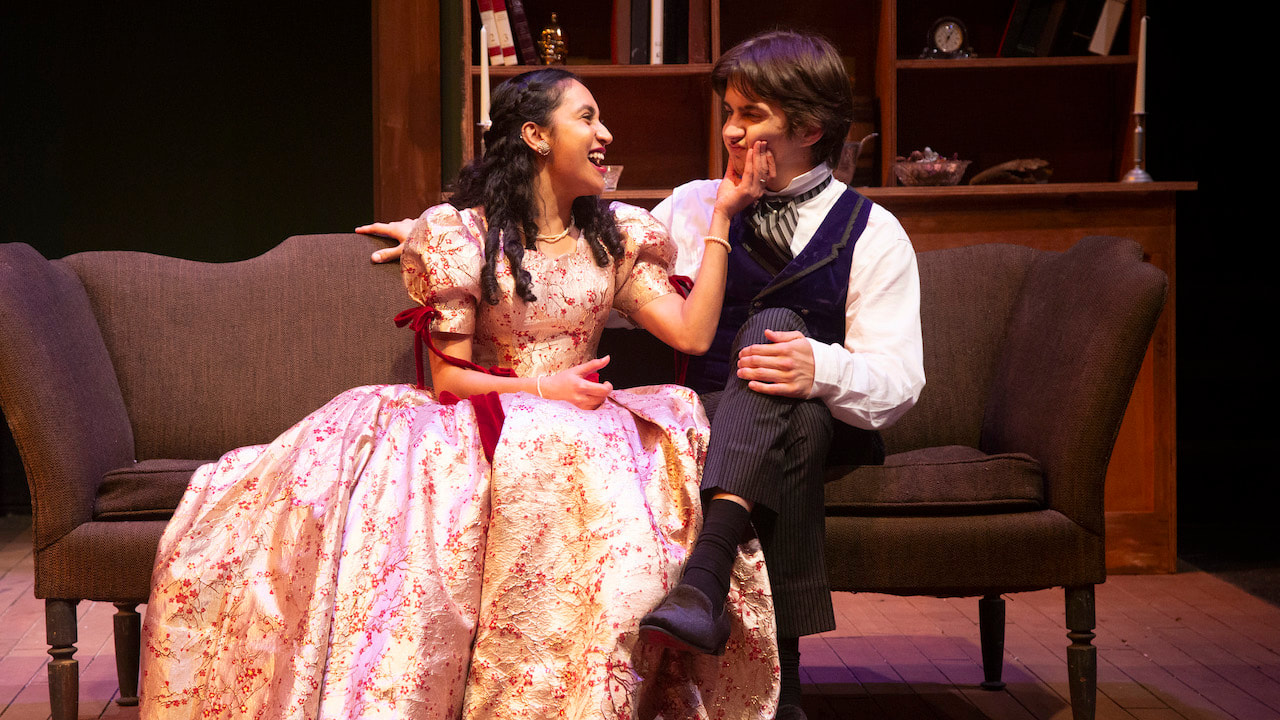|
She Stoops to Conquer, UNO Robert E Nims Theatre Review by Dorian Hatchett Watching a play originally produced in 1770s London, on stage 251 years later, is not an uncommon experience for the modern audience. Shakespeare has been getting the modern adaptation treatment for 200 years longer than that. The success of shows like Bridgerton prove that Americans crave dramas about class struggle in an England still ruled by rigid social castes and obsessive adherence to filial responsibility. Each of these modern adaptations seeks a new way to connect with the audiences of now, though (I’m lookin' at you, John Leguizamo as Tybalt, or the pop music played on celestina in Bridgerton’s ballrooms). Director Madison Smith sought to capture her American audience by setting this Georgian Era story in the 1865 Gold Rush. While waiting for the play to begin, members of the chorus (who play background and small parts throughout the show as bar patrons and servants) interact with the audience. It might have been awkward, but it set the stage well for the production; we were to remember that this was a comedy of errors of social machination, and not to be taken too seriously. The chorus of musicians plays through the interludes and transitions, and the original music composed for the play was cohesive and fun. I found myself wishing that the singers had microphones, as some of the lyrics were lost in the small auditorium. Overall, though, the vibe landed and the music was a notable and positive addition to the show. The Gold Rush-era setting was never made explicitly clear (I learned it from reading the program) but it didn’t really matter to the value of the play. The dialog of the show was left as originally written, so at times was hard to decipher to the modern vernacular ear, but the actors' physical comedy more than made up for any meaning lost to verbiage. Notable among the cast were Laszlo Fulop as Mr. Hardcastle, with a spirited intonation as the patriarch who was charmingly off-kilter but clearly adored by his family. Violetta Valverde had a dramatic physical response to every emotional trigger, endearing her to the audience despite her being the antagonist of the show. The rest of the cast all had stand-out moments: Caylee Sanders was so believable as clever, lovestruck Kate, and Morgan Hall as Sir Charles Marlowe had few lines but was by far the best vocal actor of the entire cast. The leads, however, carried the show as the adults in a room of slightly confused children, reminding the audience and supporting cast alike that to laugh at oneself is the height of wisdom. Like many plays of the era, the scope of the production was centered on emotional interchange, and this was no different. I can lovingly describe Austen as books about the horror of being perceived at the homes of other people, and She Stoops to Conquer (originally produced just two years before the birth of Jane Austen) is a clear predecessor to the tone of the soap opera-like literary devices of the time. The actors in this production are obviously comfortable with each other and the subject matter, even if they occasionally trip over the more deprecated language. The set is simple (but incredibly efficient) and it didn't overcomplicate the visual storytelling with unnecessary details. The focus was entirely on the emotions and words (and the wardrobe, which the play references often) and that was very well done on the part of the company. Confusion about the setting aside, the show was bright, well-rehearsed, and the whole experience was a delight. She Stoops to Conquer runs at UNO Robert E Nims Theatre through April 20th. Click here for show times and ticketing information. Sign up for the free Out All Day weekly newsletter, with news, reviews, interviews and more: Comments are closed.
|
NEWSPreviews, reviews, offers and news in New Orleans. Categories
All
Archives
July 2024
|

 RSS Feed
RSS Feed